Qi Shan
The Super Weight in Large Language Models
Nov 11, 2024



Abstract:Recent works have shown a surprising result: a small fraction of Large Language Model (LLM) parameter outliers are disproportionately important to the quality of the model. LLMs contain billions of parameters, so these small fractions, such as 0.01%, translate to hundreds of thousands of parameters. In this work, we present an even more surprising finding: Pruning as few as a single parameter can destroy an LLM's ability to generate text -- increasing perplexity by 3 orders of magnitude and reducing zero-shot accuracy to guessing. We propose a data-free method for identifying such parameters, termed super weights, using a single forward pass through the model. We additionally find that these super weights induce correspondingly rare and large activation outliers, termed super activations. When preserved with high precision, super activations can improve simple round-to-nearest quantization to become competitive with state-of-the-art methods. For weight quantization, we similarly find that by preserving the super weight and clipping other weight outliers, round-to-nearest quantization can scale to much larger block sizes than previously considered. To facilitate further research into super weights, we provide an index of super weight coordinates for common, openly available LLMs.
Apple Intelligence Foundation Language Models
Jul 29, 2024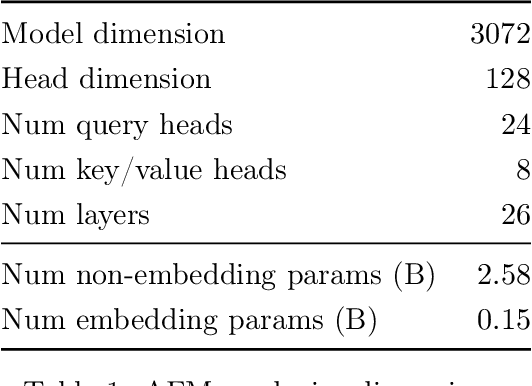
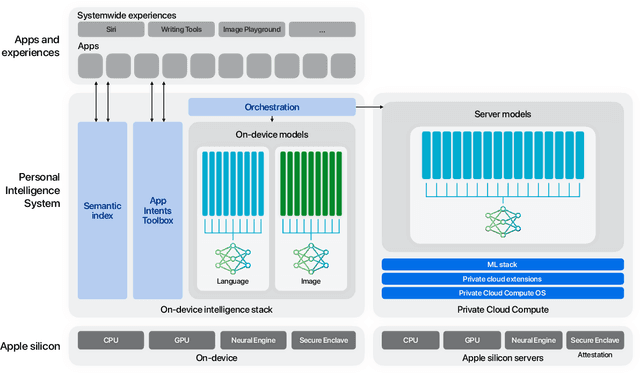

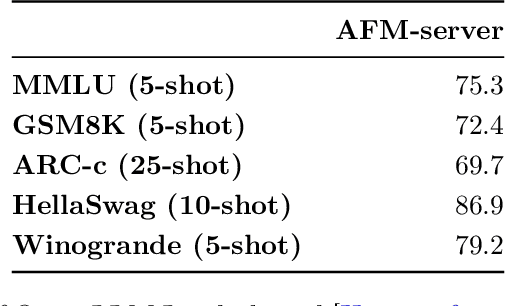
Abstract:We present foundation language models developed to power Apple Intelligence features, including a ~3 billion parameter model designed to run efficiently on devices and a large server-based language model designed for Private Cloud Compute. These models are designed to perform a wide range of tasks efficiently, accurately, and responsibly. This report describes the model architecture, the data used to train the model, the training process, how the models are optimized for inference, and the evaluation results. We highlight our focus on Responsible AI and how the principles are applied throughout the model development.
Talaria: Interactively Optimizing Machine Learning Models for Efficient Inference
Apr 03, 2024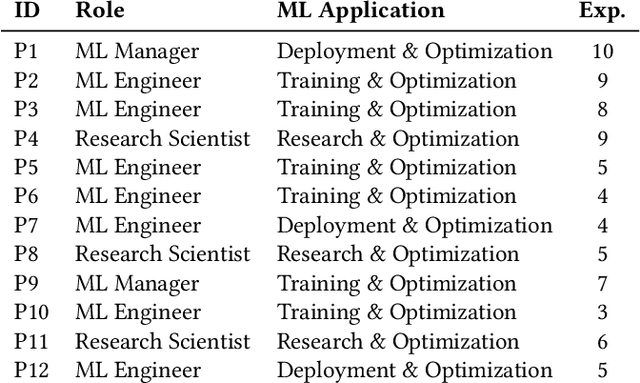
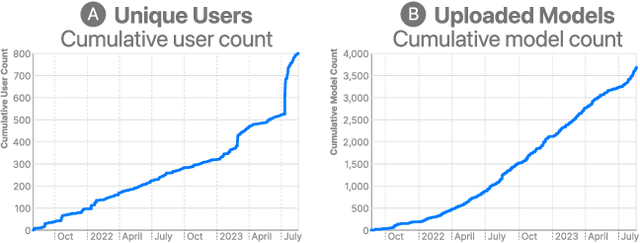

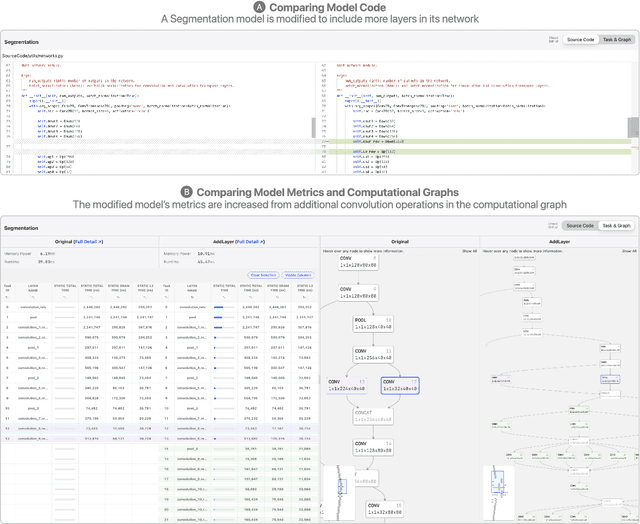
Abstract:On-device machine learning (ML) moves computation from the cloud to personal devices, protecting user privacy and enabling intelligent user experiences. However, fitting models on devices with limited resources presents a major technical challenge: practitioners need to optimize models and balance hardware metrics such as model size, latency, and power. To help practitioners create efficient ML models, we designed and developed Talaria: a model visualization and optimization system. Talaria enables practitioners to compile models to hardware, interactively visualize model statistics, and simulate optimizations to test the impact on inference metrics. Since its internal deployment two years ago, we have evaluated Talaria using three methodologies: (1) a log analysis highlighting its growth of 800+ practitioners submitting 3,600+ models; (2) a usability survey with 26 users assessing the utility of 20 Talaria features; and (3) a qualitative interview with the 7 most active users about their experience using Talaria.
StableDreamer: Taming Noisy Score Distillation Sampling for Text-to-3D
Dec 02, 2023



Abstract:In the realm of text-to-3D generation, utilizing 2D diffusion models through score distillation sampling (SDS) frequently leads to issues such as blurred appearances and multi-faced geometry, primarily due to the intrinsically noisy nature of the SDS loss. Our analysis identifies the core of these challenges as the interaction among noise levels in the 2D diffusion process, the architecture of the diffusion network, and the 3D model representation. To overcome these limitations, we present StableDreamer, a methodology incorporating three advances. First, inspired by InstructNeRF2NeRF, we formalize the equivalence of the SDS generative prior and a simple supervised L2 reconstruction loss. This finding provides a novel tool to debug SDS, which we use to show the impact of time-annealing noise levels on reducing multi-faced geometries. Second, our analysis shows that while image-space diffusion contributes to geometric precision, latent-space diffusion is crucial for vivid color rendition. Based on this observation, StableDreamer introduces a two-stage training strategy that effectively combines these aspects, resulting in high-fidelity 3D models. Third, we adopt an anisotropic 3D Gaussians representation, replacing Neural Radiance Fields (NeRFs), to enhance the overall quality, reduce memory usage during training, and accelerate rendering speeds, and better capture semi-transparent objects. StableDreamer reduces multi-face geometries, generates fine details, and converges stably.
UPSCALE: Unconstrained Channel Pruning
Jul 17, 2023Abstract:As neural networks grow in size and complexity, inference speeds decline. To combat this, one of the most effective compression techniques -- channel pruning -- removes channels from weights. However, for multi-branch segments of a model, channel removal can introduce inference-time memory copies. In turn, these copies increase inference latency -- so much so that the pruned model can be slower than the unpruned model. As a workaround, pruners conventionally constrain certain channels to be pruned together. This fully eliminates memory copies but, as we show, significantly impairs accuracy. We now have a dilemma: Remove constraints but increase latency, or add constraints and impair accuracy. In response, our insight is to reorder channels at export time, (1) reducing latency by reducing memory copies and (2) improving accuracy by removing constraints. Using this insight, we design a generic algorithm UPSCALE to prune models with any pruning pattern. By removing constraints from existing pruners, we improve ImageNet accuracy for post-training pruned models by 2.1 points on average -- benefiting DenseNet (+16.9), EfficientNetV2 (+7.9), and ResNet (+6.2). Furthermore, by reordering channels, UPSCALE improves inference speeds by up to 2x over a baseline export.
HyperDiffusion: Generating Implicit Neural Fields with Weight-Space Diffusion
Mar 29, 2023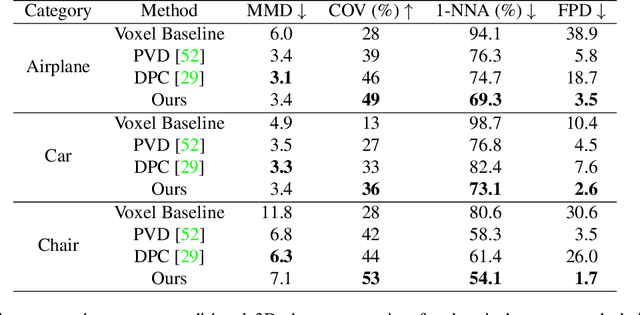
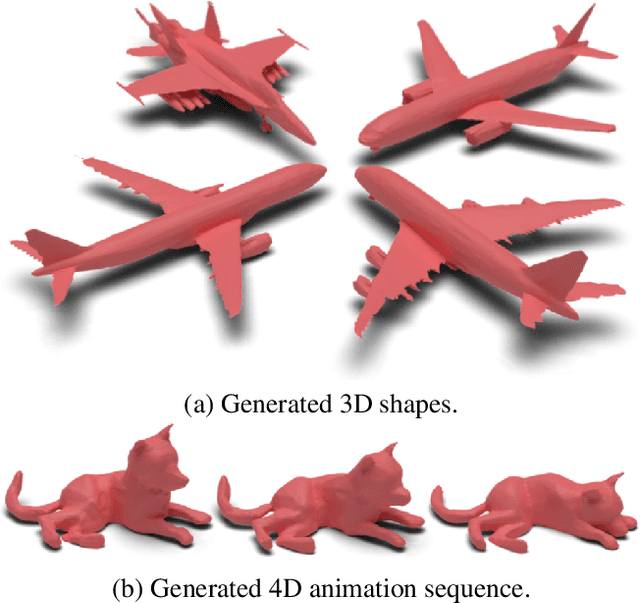

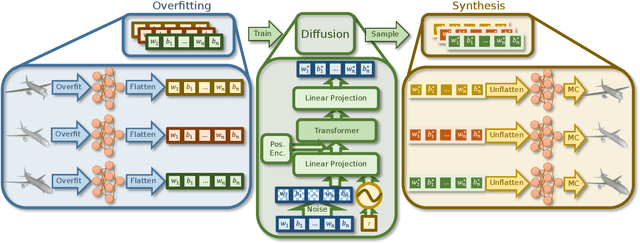
Abstract:Implicit neural fields, typically encoded by a multilayer perceptron (MLP) that maps from coordinates (e.g., xyz) to signals (e.g., signed distances), have shown remarkable promise as a high-fidelity and compact representation. However, the lack of a regular and explicit grid structure also makes it challenging to apply generative modeling directly on implicit neural fields in order to synthesize new data. To this end, we propose HyperDiffusion, a novel approach for unconditional generative modeling of implicit neural fields. HyperDiffusion operates directly on MLP weights and generates new neural implicit fields encoded by synthesized MLP parameters. Specifically, a collection of MLPs is first optimized to faithfully represent individual data samples. Subsequently, a diffusion process is trained in this MLP weight space to model the underlying distribution of neural implicit fields. HyperDiffusion enables diffusion modeling over a implicit, compact, and yet high-fidelity representation of complex signals across 3D shapes and 4D mesh animations within one single unified framework.
PointConvFormer: Revenge of the Point-based Convolution
Aug 04, 2022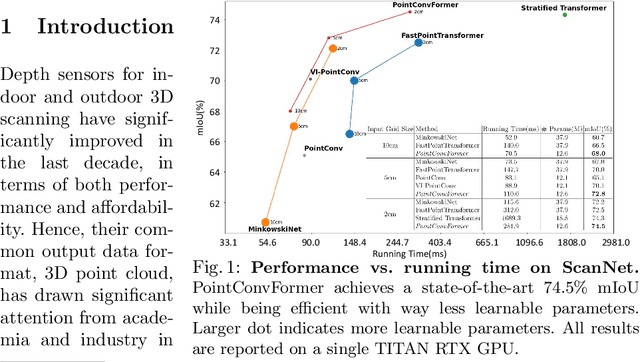
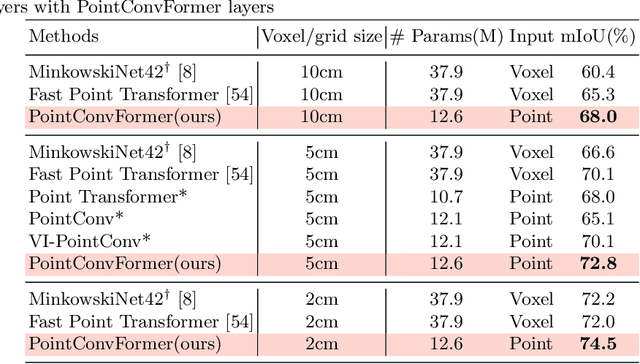
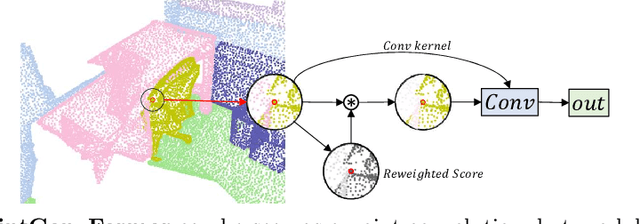
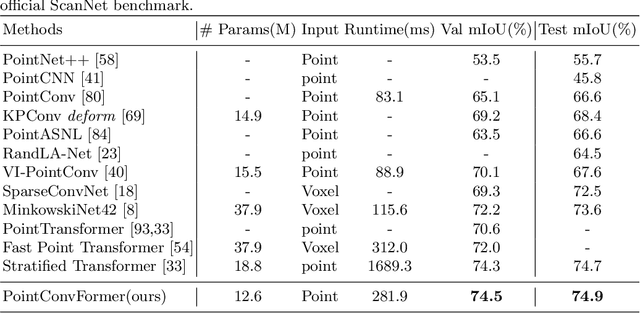
Abstract:We introduce PointConvFormer, a novel building block for point cloud based deep neural network architectures. Inspired by generalization theory, PointConvFormer combines ideas from point convolution, where filter weights are only based on relative position, and Transformers which utilizes feature-based attention. In PointConvFormer, feature difference between points in the neighborhood serves as an indicator to re-weight the convolutional weights. Hence, we preserved the invariances from the point convolution operation whereas attention is used to select relevant points in the neighborhood for convolution. To validate the effectiveness of PointConvFormer, we experiment on both semantic segmentation and scene flow estimation tasks on point clouds with multiple datasets including ScanNet, SemanticKitti, FlyingThings3D and KITTI. Our results show that PointConvFormer substantially outperforms classic convolutions, regular transformers, and voxelized sparse convolution approaches with smaller, more computationally efficient networks. Visualizations show that PointConvFormer performs similarly to convolution on flat surfaces, whereas the neighborhood selection effect is stronger on object boundaries, showing that it got the best of both worlds.
FvOR: Robust Joint Shape and Pose Optimization for Few-view Object Reconstruction
May 16, 2022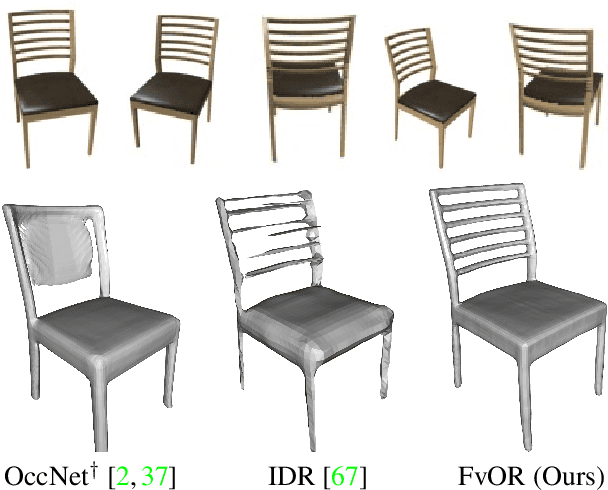

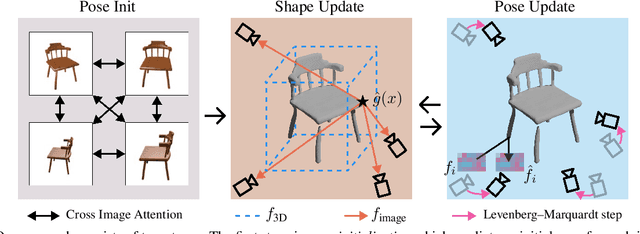

Abstract:Reconstructing an accurate 3D object model from a few image observations remains a challenging problem in computer vision. State-of-the-art approaches typically assume accurate camera poses as input, which could be difficult to obtain in realistic settings. In this paper, we present FvOR, a learning-based object reconstruction method that predicts accurate 3D models given a few images with noisy input poses. The core of our approach is a fast and robust multi-view reconstruction algorithm to jointly refine 3D geometry and camera pose estimation using learnable neural network modules. We provide a thorough benchmark of state-of-the-art approaches for this problem on ShapeNet. Our approach achieves best-in-class results. It is also two orders of magnitude faster than the recent optimization-based approach IDR. Our code is released at \url{https://github.com/zhenpeiyang/FvOR/}
Texturify: Generating Textures on 3D Shape Surfaces
Apr 05, 2022

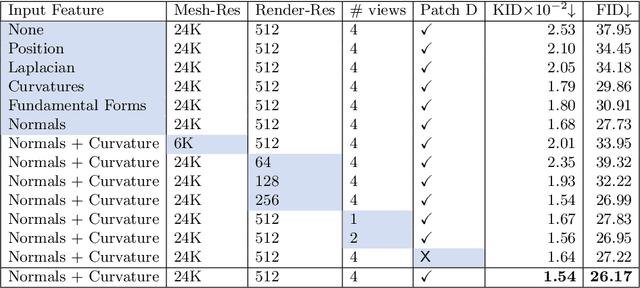

Abstract:Texture cues on 3D objects are key to compelling visual representations, with the possibility to create high visual fidelity with inherent spatial consistency across different views. Since the availability of textured 3D shapes remains very limited, learning a 3D-supervised data-driven method that predicts a texture based on the 3D input is very challenging. We thus propose Texturify, a GAN-based method that leverages a 3D shape dataset of an object class and learns to reproduce the distribution of appearances observed in real images by generating high-quality textures. In particular, our method does not require any 3D color supervision or correspondence between shape geometry and images to learn the texturing of 3D objects. Texturify operates directly on the surface of the 3D objects by introducing face convolutional operators on a hierarchical 4-RoSy parametrization to generate plausible object-specific textures. Employing differentiable rendering and adversarial losses that critique individual views and consistency across views, we effectively learn the high-quality surface texturing distribution from real-world images. Experiments on car and chair shape collections show that our approach outperforms state of the art by an average of 22% in FID score.
Fast and Explicit Neural View Synthesis
Jul 12, 2021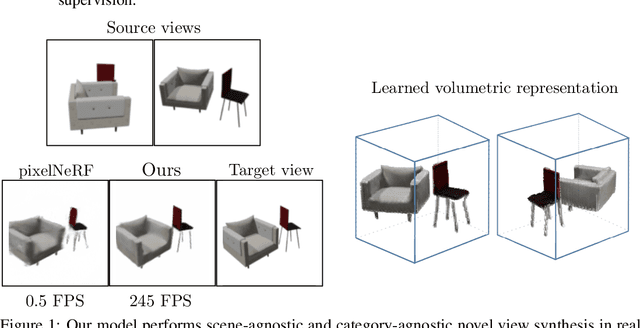



Abstract:We study the problem of novel view synthesis of a scene comprised of 3D objects. We propose a simple yet effective approach that is neither continuous nor implicit, challenging recent trends on view synthesis. We demonstrate that although continuous radiance field representations have gained a lot of attention due to their expressive power, our simple approach obtains comparable or even better novel view reconstruction quality comparing with state-of-the-art baselines while increasing rendering speed by over 400x. Our model is trained in a category-agnostic manner and does not require scene-specific optimization. Therefore, it is able to generalize novel view synthesis to object categories not seen during training. In addition, we show that with our simple formulation, we can use view synthesis as a self-supervision signal for efficient learning of 3D geometry without explicit 3D supervision.
 Add to Chrome
Add to Chrome Add to Firefox
Add to Firefox Add to Edge
Add to Edge